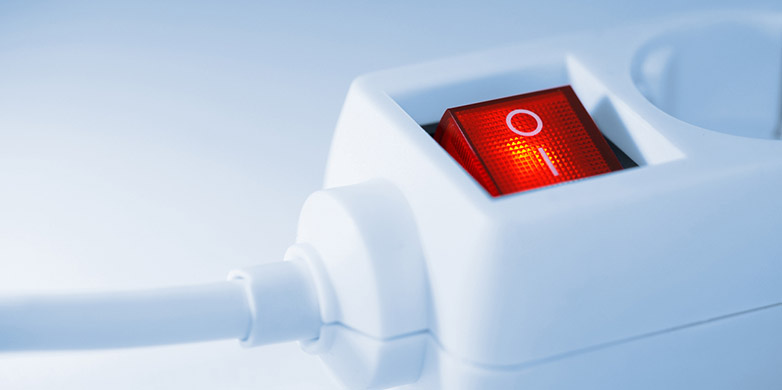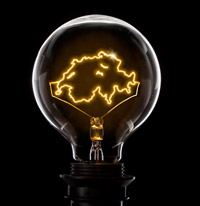Swiss households could save energy
Efficient use of electricity is central to Energy Strategy 2050. But how much electricity-saving potential do Swiss households actually have? And which factors influence this efficiency?

Energy Strategy 2050 specifies that Switzerland should gradually phase out nuclear energy. The resulting electricity deficit should be covered by new renewable energy, further expansion of hydropower, and, notably, by an increase in energy efficiency. Based on this proposal, electricity consumption per capita will be 3 percent lower by 2020 than it was in the year 2000, and 13 percent lower by 2035. But is this a realistic target?
Re-evaluating the efficiency potential of Swiss households

At ETH Zurich’s Centre for Energy Policy and Economics (CEPE), we have been working for several years to determine the efficiency potential for electricity consumption in Swiss households. Engineers traditionally estimate potential based on a so-called “bottom-up” approach, in which they measure the potential of individual households and then project this onto the entire population. A 2011 Prognos study [1] applied this approach to Switzerland and determined a household electricity-saving potential of 15 percent by 2035. A disadvantage of this method is that it makes assumptions about future technologies – something which is fraught with uncertainty.
Our approach, by contrast, is “top-down”, and calculates what is known as a “best practice electricity demand curve” based on a current and representative data set on Swiss households (see my earlier blog entry on this). Points on this curve represent what are currently the most efficient households. These are equipped with the newest and most efficient appliances and are making optimal use of them. For all other households, we can measure the distance to the curve in order to determine the level of efficiency. This allows us to estimate potential with reference to the best technologies available at this point in time, and to take consumer behaviour into account without having to make assumptions about future technologies.
We used this approach in a recently published article [2] to estimate a total electricity-saving potential of 20–25 percent in Swiss households. This is comfortably above the total potential of 13 percent estimated by Prognos in 2011. It is also above the guideline value of a 15 percent saving set out by Energy Strategy 2050 – although this was specified as a per capita rather than an absolute value, which means a direct comparison is not entirely valid. Nevertheless, our results indicate that not only is the guideline value realistic, there may be even greater potential than anticipated.
Considerable standby consumption
There are two reasons for the gap between optimal and actual household electricity consumption. On the one hand, a household might be using old, inefficient appliances. On the other hand, it could be that a household is not using its appliances in the most efficient way. This is the case, for example, with standby consumption. Based on figures from the Swiss Federal Office of Energy (SFOE) [3], we were able to ascertain that standby consumption alone represents a significant share of a household’s total electricity consumption – between 6 and 14 percent. With some astonishment, we asked ourselves if households that avoid standby actually demonstrate a higher level of efficiency. We were able to show that this is in fact the case. In “bottom-up” studies, behavioural aspects such as this are not sufficiently taken into account – if at all – which is an advantage of our method.
Filling in the gaps
After this initial rough estimation of Swiss potential, we are now trying to investigate the gap between actual and optimal electricity consumption in greater detail. Behavioural economic aspects are of particular interest to us here. The results of a new working paper [4] indicate that households with a better awareness of energy and investment issues tend to have lower levels of electricity consumption. We also want to find out if we can influence the rate of replacement for household appliances by means of information and training. This could provide indications of which political measures to pursue in future.
Further information
[1] Prognos (2011), Energieszenarien für die Schweiz bis 2050 (Energy scenarios for Switzerland by 2050), Erste Ergebnisse der angepassten Szenarien I und IV aus den Energieperspektiven 2007 - Zwischenbericht im Auftrag des BFE (First results from adapted scenarios I and IV from 2007 energy perspectives – Interim external pagereportcall_made on behalf of the SFOE).
[2] Boogen, N. (2017), Estimating the potential for electricity savings in households, external pageEnergy Economicscall_made (63), pp. 288–300.
[3] SFOE (2006), Standby-Verbrauch im Haushalt – Schlussbericht im Auftrag des BFE, Bundesamt für Energie (BFE), Bern (Standby consumption in households – final external pagereportcall_made on behalf of the SFOE, Swiss Federal Office of Energy, Bern)
[4] Blasch, J., Boogen, N., Filippini, M. and Kumar, N. (2017), The role of energy and investment literacy for residential electricity demand and end-use efficiency, CER-ETH Working Paper 17/269.
